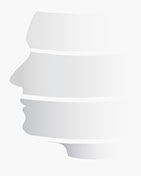Other Headache Types
Also called rebound headaches or drug induced headaches. Often these are mistaken for tension or stress headaches. These are headaches that are treated with abortive medications that try to stop or reduce the pain of the headache more than 15 days per month for 3 months and are getting worse or harder to treat. Most abortive medications (triptans like Imitrex and ergotamines like Cafergot or Migranal and combination medications like Excedrin) can cause MOH if taken more than 10 days per month. Simple analgesics ( like Tylenol and Aleve) take longer to cause this problem (15 days per month) and opioids (narcotics like Vicodin) and barbiturates (butalbital containing drugs like Fioricet or Fiorinal) can do it in as little as 4 days per month. Stopping the medication can reduce or completely stop these headaches if you stay off the drug for 1-2 months. Abruptly stopping drugs that have been taken in sufficient quantity or for a long period of time may cause withdrawal symptoms and even be dangerous to do without medical advice. Again the opioids and the barbiturates are the two most dangerous.
Not an uncommon type of daily continuous headache seen in Headache Clinics as this diagnosis is often missed by even general neurologists. The headache starts unexpectedly, usually upon awakening and if not, then the patient often remembers the exact activity/time when it started. Typically, there is no prior headache history and the associated symptoms can be similar to migraine or even tension headaches. They do not respond to triptans (used to treat migraine and cluster headaches) and rarely do they respond to normal preventative medications. There are several secondary (from other causes like low level of cerebral spinal fluid) headaches that can imitate a New Daily Persistent Headache. There are two forms of this headache type; the milder type that resolves in several months without treatment and the refractory type that does not respond to even aggressive treatment.
This headache, although benign (not serious) can be quite severe and of sudden onset usually within seconds of coughing, sneezing or other valsalva maneuvers (like straining for a bowel movement). The bilateral (both sides) headaches usually resolve in minutes but can leave a lasting low level dull ache for hours after the initial onset. Nausea and vomiting and neurologic symptoms (visual changes, numbness, dizziness, weakness, confusion) are absent. These headaches are more common in men over the age of 40.
Also known as ice pick pain, jolts or jabs or zingers, these headaches are attacks of brief localized stabbing or sharp pains lasting 2-10 seconds but can last up to several minutes. These can happen multiple times per day and rarely for more than a few days. The stabs can move around the head but are usually confined to the 1st branch of the trigeminal nerve (the forehead and tops and sides of the head back to the ears) and occasionally in the territory of the occipital nerve (back of the head, behind the ears to the junction of the head and neck). It is not uncommon for adult patients to suffer from undiagnosed migraines or cluster headaches but they can occur in children without a headache history. Most go away on there own. However, the children may go on to develop a typical primary headache disorder.
Bilateral (both sides) headache that occur during or after physical activity and are similar to cough headaches but usually last longer (up to 48 hrs). When they occur later in life or are one-sided, a complete workup for a secondary cause is warranted.
This is a severe headache that is of sudden onset (usually less than one minute) that can last several hours. The first headache of this type should be worked up on an emergent basis. (Aneurismal headaches can seem like thunderclap headaches and are a serious medical emergency.) However, when these headaches are investigated without a cause found they are thought to be a part of a migraine syndrome.
Also known as alarm clock headaches as they wake the sufferer out of sleep at about the same time every night. The pain is usually mild to moderate and lasts 30 min to 180 min and often occurs more nights than not during the month.
A continuous headache that is only on one side. It is a unique headache in that it only responds to a prescription strength anti inflammatory indomethacin. In rare cases there have been spontaneous remissions (they stop on their own).
As the title denotes, these headaches occur around sexual activity. They occur more in men and are benign (not serious) and are classified into two types; Preorgasmic and Orgasmic. Twenty percent of sufferers of sex headaches have preorgasmic sex headaches that resemble tension type headaches involving the muscles of the head and neck, are dull and can be reduced or prevented by relaxation. They often build as the sexual excitement does. The other 80 % experience orgasmic headaches that are explosive, can be accompanied by nausea and vomiting and last from minutes to even hours and occur at the time or right around the time of orgasm. These patients often have previous history of migraine. For most patients these are self limited headaches but can be unpredictable and reoccur several times throughout their lifetime.
Headaches in this group of disorders are severe, brief and have autonomic features ( tearing and nasal congestion like cluster headaches). This group includes cluster (discussed in its own section), paroxysmal hemicranias and short-lasting unilateral neuralgiform headaches with conjunctival injection (SUNCT). The paroxysmal hemicranias are a group of rare but benign (not serious) headaches that are similar to cluster headaches but respond to indomethacin and not to traditional cluster treatments. The chronic form is much more common and has a 2:1 female preponderance and 20% have a family migraine history, but interestingly not a family history of cluster headaches. SUNCT syndrome is probably the rarest and most unusual of the primary headache disorders. They occur more often in men and are very brief pain episodes that are felt in the first branch (ophthalmic) of the trigeminal nerve (sensory nerve of the face). The one-sided pain has a burning, stabbing, almost shock like character to it and it can radiate from around the eye to the forehead, nose, cheek, upper palate and from the temple into the ear. The attacks last 2-3 seconds but can last as long as several minutes and can occur 3-200 times per day. There is prominent tearing and redness of the affected eye. Some patients report being able to trigger attacks by touching parts of their face or turning their heads. Unlike trigeminal neuralgia (which it is often confused with), most suffers do not experience a refractory period (remissions) and there can be nocturnal attacks.
Medication Overuse Headaches
New Daily Persistant Headache
Primary Cough Headache
Primary Stabbing Headache
Primary Exertional Headache
Primary Thunderclap Headache
Hypnic Headache
Hemicrania Continua
Primary Sex Headache
Trigeminal Autonomic Cephalagias
Site Map
Disclaimer




